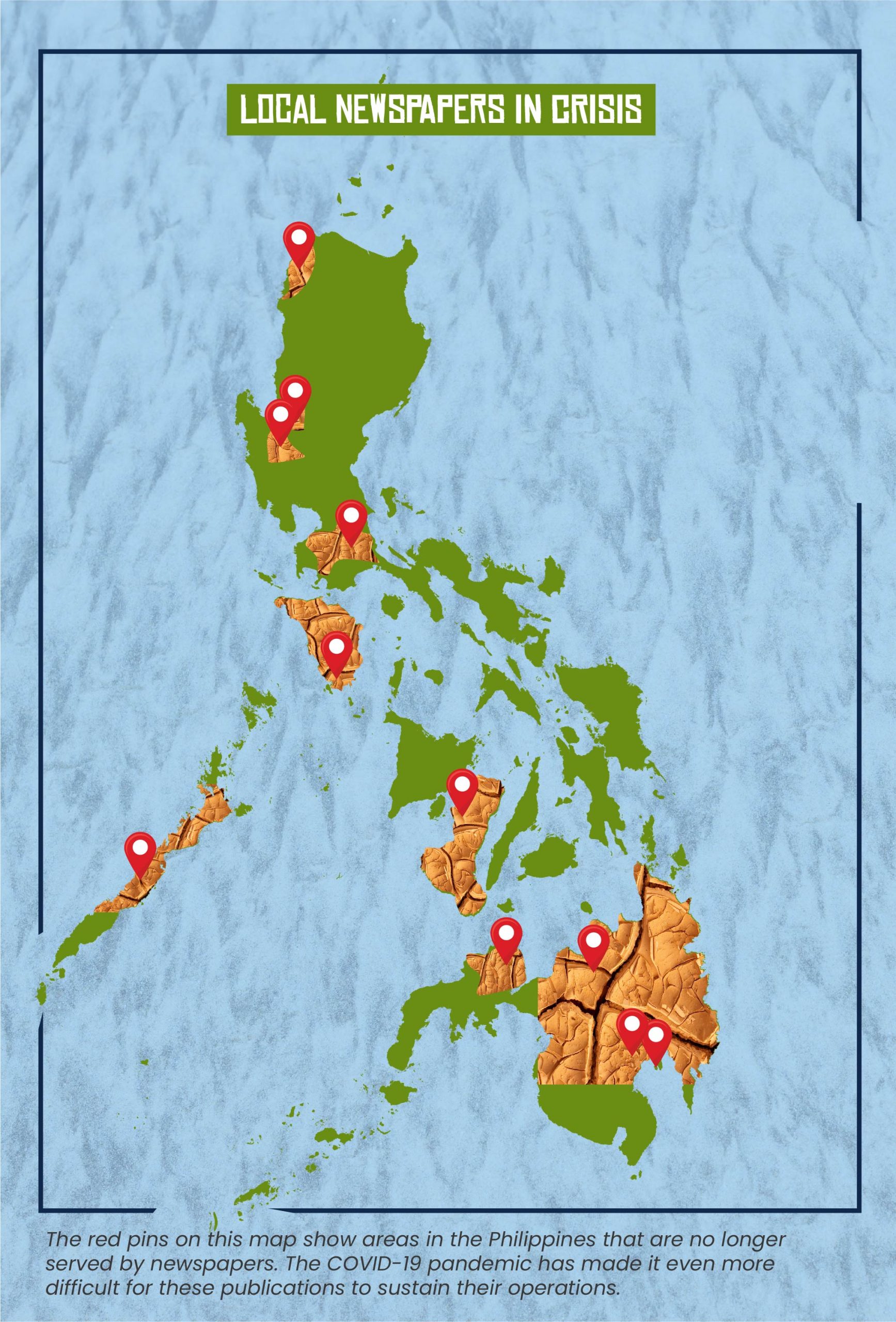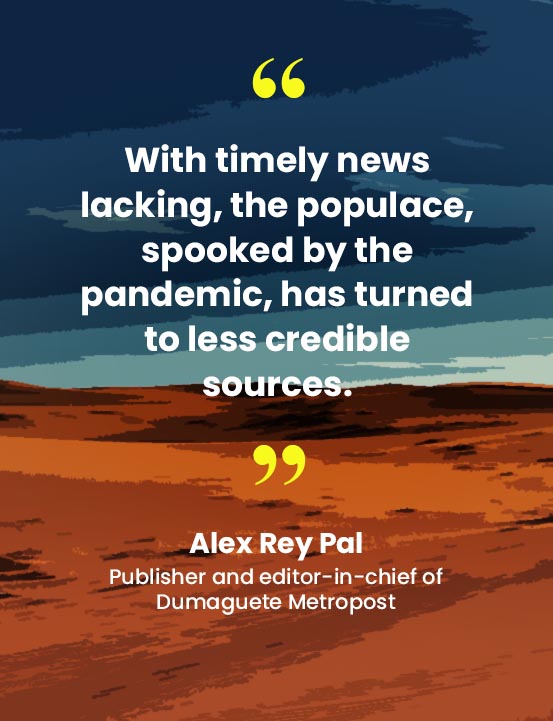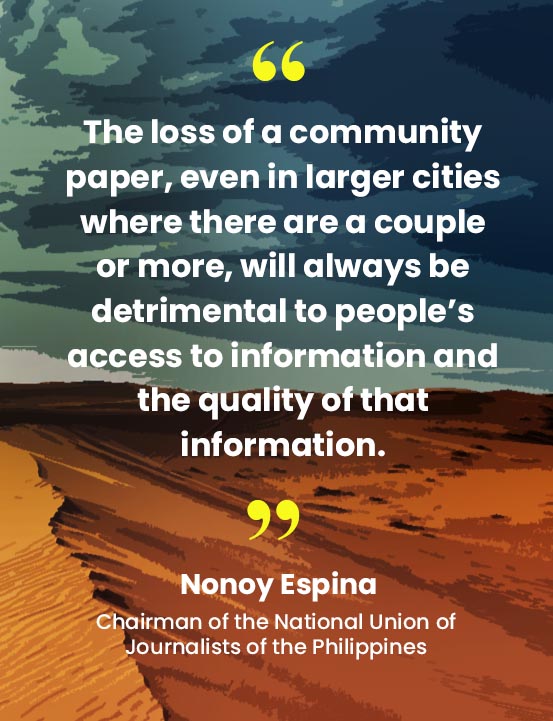News deserts — patches of areas that are not served by daily local newspapers — are emerging in the Philippines, leaving communities with little to no access to timely local news during a public health crisis.
The country, which has figured in the world’s longest COVID-19 lockdown, has seen economic growth halted, with the unemployment rate reaching a record high of 45.5 percent in July. One of the unforeseen side effects of the downturn has been the suppression of local news. Community papers, a majority of which have limited circulation in secondary metropolitan areas, are now struggling to stay afloat.

With the country’s economy taking a nosedive and amid shrinking ad revenue, a number of local newspapers have been forced to shut down – a situation incongruous with how essential they are to the communities they cover, especially during a prolonged crisis like today’s pandemic.
“The serious economic downturn brought by the pandemic has left many community media outfits treading water, and belts have had to be painfully tightened,” said Nonoy Espina, the chairman of the National Union of Journalists of the Philippines.
Alex Rey Pal, the publisher and editor-in-chief of Dumaguete Metropost, a weekly paper in the southern part of the country, is treading water with his peers. Pal said that advertising revenue for his paper continues to shrink as the pandemic lingers. Nowadays, the Metropost’s main source of advertising money are public notices relating to court announcements and local government financial statements.
“Our display ads dwindled substantially because many businesses are closed. They don’t have a reason to advertise anymore,” Pal said.
Amalia Bandiola, the editor-in-chief of Mindanao Times, a daily newspaper in Davao City in southern Philippines, reported a similar drop in ad revenue. However, what shielded her publication were ad packages that were sold six months to a year in advance.
Such hard financial situations are not unique or new in community journalism. This was the case even before the pandemic.
“Most community publications will say sustaining revenues has always been the major problem and the pandemic has only made it that much worse,” Espina said.
The dim economic prospects of local newspapers are incongruous with how essential they are to the communities they cover, especially during a prolonged crisis like a pandemic.
“People are hungry for information because many of them avoid going out. So they don’t really know much about what’s happening,” Pal said.
Hunger for information is more pronounced in places like Dumaguete. The city, the capital of the province of Negros Oriental in the Central Visayas region, has a population of 131,377 people, according to the latest (2015) census. Yet, it is as a news desert. According to Pal, only one other newspaper — Negros Chronicle — covers the area. It is also a weekly paper.
With timely news lacking, the populace, spooked by the pandemic, has turned to less credible sources. “There are a lot of rumors going around because of the lack of information,” Pal said.
 Physical paper
Physical paper
While it’s unclear how many people live in news deserts in the country, data suggests that the numbers are not modest.
According to Ariel Sebellino, the executive director of media organization Philippine Press Institute, a total of 12 local newspapers as of late October have ceased printing since the start of the pandemic. Mindanao Times, which stopped printing from March 15 to July 3, was not included in the list.
“One community paper that closes down is one too many. We cannot underestimate the closure of one newspaper,” Sebellino said.
“The loss of a community paper, even in larger cities where there are a couple or more, will always be detrimental to people’s access to information and the quality of that information,” Espina added.
Access to information, especially in isolated areas with little to no Internet penetration, already took a hit with the closure of ABS-CBN, the country’s largest television network. The company, which has been operating since 1953 (dictator Ferdinand Marcos shut it down between 1972 and 1986), closed 53 regional television and radio stations that broadcast in six different languages last August. The move came after the House of Representatives denied ABS-CBN’s application for a 25-year franchise renewal. The development, which critics described as “a black day for independent journalism,” continues to leave millions of people with reduced or no local news coverage.
In the Philippines, a country where only 45 percent of adults have access to the Internet, newspapers, particularly its printed editions, could have filled the gaps. Instead, the inactivity of community papers has left people with nowhere to turn for local news.
Over the past few years, Filipino newspapers, including major broadsheets with national circulation, have seen falling readership numbers. According to a 2019 Social Weather Station (SWS) survey, only 1.5 percent of adults in the country read newspapers every day.
This tepid attitude towards newspapers may be less pronounced in the countryside. Bandiola said that many readers still want physical copies of newspapers, in spite of the risks involved with touching newsprint during a pandemic.
“They still want the paper. They do go online. But they’d rather have the paper,” she said, adding that the Times’ readers, many of whom are older, continue to stick to their routine of reading the newspaper in the morning.
Espina said that many community papers have never had wide readership. He also suspects that many publications pad their circulation numbers. However, he claims that the value of local papers goes beyond sales figures.
“While radio will still be the dominant medium for news in communities, newspapers invariably remain the preferred source of news and information by the business sector, local government officials, and other policy makers, mainly because stories in print almost always provide more detail than radio reports,” he said.
Journalism in the time of pandemic
The pandemic has essentially overhauled community journalism. This goes for everything, from the process of gathering news to the way reporters interact with sources.
The most glaring, and perhaps most damaging, change has been to the headcount in newsrooms. “A lot of journalists are out of work,” Sebellino said.
While the NUJP has no official data on how many journalists have lost their jobs, the effect of newly untethered reporters on community journalism is conspicuous. Many out-of-work reporters have turned to social media platforms like Facebook, generating enough clout to compete against established news outlets.
While Espina welcomes this development, he says that it also brings to light a whole new set of safety concerns. In the Philippines, which ranked fifth as the deadliest country for journalists in 2019, such concerns are more concrete than in other countries.
Espina pointed to the case of Jobert Bercasio, an online journalist who was shot dead in Sorsogon City, about seven hours’ drive from Manila, last September. According to the NUJP, Bercasio, who was a critic of illegal logging and mining in the city, was the 17th media practitioner killed under President Rodrigo Duterte’s administration.
The pandemic has short-circuited many aspects of local newspaper operations. According to Bandiola, the Times was able to avoid any layoffs. However, their reporters now only work three times a week and have had their salaries cut in half. Their print edition is now also much thinner, with the page count dropping from 28 to 12 pages.
Pal, meanwhile, said that his newspaper, which makes most of its money from sales of printed copies, had to deal with choke points in their circulation early in the pandemic. This led to a reduction in the Metropost’s circulation – from 1,000 copies to 800 copies per week.
“We had a hard time in our circulation of the hard copy because nobody would deliver the newspapers because of the ECQ, Pal said, referring to “enhanced community quarantine,” the most stringent tier of the country’s COVID-19 lockdown.
“It’s very difficult, because we’re a weekly; it’s very difficult to make the news boys come to work for just one day a week. Unlike when (Philippine Daily) Inquirer, (Manila) Bulletin and other newspapers from Manila came … the news boys had something to do every day.”

But perhaps the most worrying development is the tighter grip of local authorities on the flow of official information. According to Espina, with reporters staying at home and press conferences going fully online, local officials are taking advantage to carve an avenue for retaliation against critical reports.
“We have heard of reporters being excluded from Messenger or Viber groups, where news sources post announcements, statements, tips and other matters. In some cases, questions are even screened,” he said.
The Philippines has a long history of reprisals against critical journalists. However, according to Espina, community reporters have it worse than those in national broadsheets, because they “bear the brunt of hostility from state forces.” He says he doesn’t expect the situation to change under President Duterte, whom he described as having an “abhorrence for criticism and dissent.”
“For as long as hostility and repression is there, and media gets demonized, it would not be a good situation for a lot of community newspapers. With the Duterte administration, it’s going to be this way unfortunately,” Sebellino added.
Sebellino has a very optimistic view of the community newspaper landscape once the pandemic is over.
“We’re positive that they will go back once things normalize,” he said, dismissing the media industry’s troubles are merely cyclical. “Hopefully next year when businesses go up.”
Meanwhile, Pal, like most of his peers, wonders whether his paper will see the end of the pandemic.
“For newspapers, we’re probably at a crossroads at this point,” Pal said. “We’ll just keep trying our best to survive.” ●
Christian Brazil Bautista has worked in both the United States and the Philippines, reporting and editing for The Real Deal, Digital Trends, Financial Times, Real Estate Weekly, Yahoo! Southeast Asia and Rappler.


















